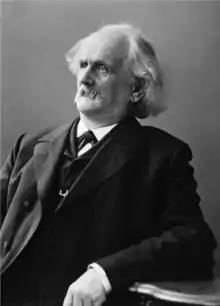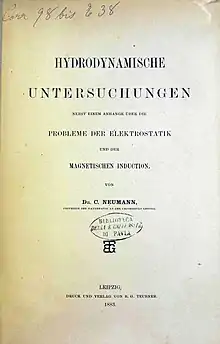Carl Neumann
Carl Gottfried Neumann (also Karl; 7 May 1832 – 27 March 1925) was a German mathematician.
Carl Neumann | |
|---|---|
 | |
| Born | 7 May 1832 |
| Died | 27 March 1925 (aged 92) |
| Nationality | German |
| Alma mater | Königsberg University Halle |
| Known for | Neumann boundary condition Neumann polynomial Neumann series Neumann–Poincaré operator |
| Awards | Pour le Mérite (1860) |
| Scientific career | |
| Fields | integral equations |
| Institutions | University of Halle-Wittenberg University of Basel University of Tübingen University of Leipzig. |
| Thesis | De problemate quodam mechanico, quod ad primam classem integralium ultraellipticorum revocatur[1] |
| Doctoral advisor | Friedrich Richelot and Otto Hesse |
| Doctoral students | William Edward Story Emil Weyr |
Biography
Neumann was born in Königsberg, Prussia, as the son of the mineralogist, physicist and mathematician Franz Ernst Neumann (1798–1895), who was professor of mineralogy and physics at Königsberg University. Carl Neumann studied in Königsberg and Halle and was a professor at the universities of Halle, Basel, Tübingen, and Leipzig.
While in Königsberg, he studied physics with his father, and later as a working mathematician, dealt almost exclusively with problems arising from physics. Stimulated by Bernhard Riemann's work on electrodynamics, Neumann developed a theory founded on the finite propagation of electrodynamic actions, which interested Wilhelm Eduard Weber and Rudolf Clausius into striking up a correspondence with him. Weber described Neumann's professorship at Leipzig as for "higher mechanics, which essentially encompasses mathematical physics," and his lectures did so.[2] Maxwell makes reference to the electrodynamic theory developed by Weber and Neumann in the Introduction to A Dynamical Theory of the Electromagnetic Field (1864).
Neumann worked on the Dirichlet principle, and can be considered one of the initiators of the theory of integral equations. The Neumann series, which is analogous to the geometric series
but for infinite matrices or for bounded operators, is named after him.
Together with Alfred Clebsch, Neumann founded the mathematical research journal Mathematische Annalen. He died in Leipzig.
The Neumann boundary condition for certain types of ordinary and partial differential equations is named after him (Cheng and Cheng, 2005).
Works by Carl Neumann


- Lösung des allgemeinen Problemes über den stationären Temperaturzustand einer homogenen Kugel ohne Hülfe von Reihen-Entwicklungen (in German). Halle: Schmidt. 1861.
- Allgemeine Lösung des Problemes über den stationären Temperaturzustand eines homogenen Körpers, welcher von irgend zwei nichtconcentrischen Kugelflächen begrenzt wird (in German). Halle: Schmidt. 1862.
- Magnetische Drehung der Polarisationsebene des Lichtes (in German). Halle: Buchhandlung des Waisenhauses. 1863.
- Theorie der Elektricitäts- und Wärme-Vertheilung in einem Ringe (in German). Halle: Buchhandlung des Waisenhauses. 1864.
- Das Dirichlet'sche Princip in seiner Anwendung auf die Riemann'schen Flächen (B. G. Teubner, Leipzig, 1865)
- Vorlesungen über Riemann's Theorie der Abel'schen Integrale (B. G. Teubner, 1865)
- Die Haupt- und Brenn-Puncte eines Linsen-Systemes (in German). Leipzig: Benedictus Gotthelf Teubner. 1866.
- Theorie der Bessel'schen functionen: ein analogon zur theorie der Kugelfunctionen (B. G. Teubner, 1867)
- Untersuchungen über das Logarithmische und Newton'sche potential (B. G. Teubner, 1877)
- Hydrodynamische Untersuchungen (in German). Leipzig: Benedictus Gotthelf Teubner. 1883.
- Über die Methode des arithmetischen Mittels (S. Hirzel, Leipzig, 1887)
- Allgemeine Untersuchungen über das Newton'sche Princip der Fernwirkungen, mit besonderer Rücksicht auf die elektrischen Wirkungen (B. G. Teubner, 1896)
- Die elektrischen Kräfte (Teubner, 1873–1898)
Notes
References
- O'Connor, John J.; Robertson, Edmund F., "Carl Neumann", MacTutor History of Mathematics Archive, University of St Andrews
- Carl Neumann at the Mathematics Genealogy Project
- Cheng, A. and D. T. Cheng (2005). Heritage and early history of the boundary element method, Engineering Analysis with Boundary Elements, 29, 268–302.